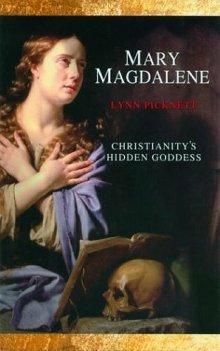
![]()
Mary Magdalene
 


The Mary Magdalene statue in the grotto at the mysterious village of Le Carol in the Ariège, France |
'A historical detective, using scholastic and heretical sources, Picknett reveals the story of the real Mary Magdalene.' Publishers Weekly 'A thought-provoking book that considers many issues, not least the role and image of women in Christianity.' Good Book Guide The two millennia of Church propaganda are over: Mary Magdalene, long patronised and marginalised as a reformed prostitute, can now assume her rightful place in the history of the Christian religion - by Christ's side, as his lover, spiritual equal, officiating priestess and even his chosen successor. Representative of the Sacred Feminine - a human woman embodying the principles of the Great Goddess, beloved across the ancient world - Mary was the object of hatred and fear for the early Church Fathers. In crafting their own version of Christianity, and brutally suppressing anyone who held opposing views, they sought to recreate this feisty, intelligent and highly sexual woman as the dregs of humanity, so overcome by her alleged past as a prostitute that the rest of her life was spent in pathological self hatred. Yet in making Mary the Magnificent come so low, the leaders of the early Vatican were actually opposing Christ's own wishes. In the Gnostic Gospels - such as the Gospels of Philip, Thomas and Mary Magdalene - it is perfectly obvious that Jesus thought of her as 'the Apostle of the Apostles', the 'Woman Who Knows All', who would sit at his right hand throughout all eternity. The Gnostic Gospels also tell how she was threatened and hated by Saint Peter, whom Jesus despaired of for his stupidity - hardly the individual on whom he intended to build his church! 
The alleged skull of Mary Magdalene at Saint-Maximin in Provence, France And is it any coincidence that the canonical, Biblical gospels of Matthew, Mark, Luke and John barely mention her by name, while she is the star of those gospels the Church Fathers voted to reject? Mary Magdalene: Christianity's Hidden Goddess (2003), which is dedicated 'To all those who have suffered at the hands of the Church', suggests that, as modern translations call her 'Mary called Magdalene', this is a title, similar to that of the great Old Testament Queen of Sheba who was known as 'Magda' - 'Great Lady'. Was Mary Magdalene, like Sheba - with whom she is linked, even by the Church - also a black woman of aristocratic pedigree, probably of Egyptian origin? This might help explain why the male disciples - clearly not Christ's inner circle as we have been led to believe for 2000 years - found her intimidating and threatening. Egyptian women were the most liberated of the ancient world, rich women especially so, and clearly she failed to behave like a typically submissive woman of 1st-century Palestine. Jesus even kissed her in full view of the other disciples, and condoned her wearing her hair unveiled in public - which was deemed so outrageous that a woman could be divorced for doing so. He was clearly besotted with her. In the inevitable Church backlash against the new eagerness for the Gnostic Gospels that has been fuelled world-wide by The Da Vinci Code, the Gnostic Gospels have been hastily denounced as of dubious theology. Yet - although they can be quaint and difficult to read, especially the passages dealing with the convoluted Gnostic cosmology - when they describe the relationships within Jesus' mission, they are not only consistent but clearly drawing on the same source. Christ and Mary, Mary and Peter (and the other disciples) are depicted so vividly that it is obvious they are based on something real. If they had merely been invented, there would have been no mutterings in the ranks, no profound clash, no death threats. All would have been sweetness and light. To the Church the message is clear: The real Mary Magdalene is back. Get used to it. 
Mary Magdalene on the altar in the church of St Mary Magdalene in the village of Rennes-le-Château, southern France
|